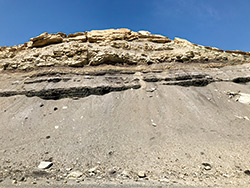 |
| Low-grade coal, carbonaceous shale, and sandstone in the Naturita Formation |
A thin but conspicuous rock layer (a formation to geologists) is found in southeastern Utah; one that tells an important geologic story. This layer consists of tan sandstone, along with some low-grade coal and carbonaceous shale, that was deposited approximately 98 million years ago. It sits just below the imposing gray cliffs of the Mancos Shale in the Book Cliffs north of Moab. Near the base, the layer has a type of cross-bedding and other features that indicate that these sands were transported by rivers. The coal, carbonaceous gray shale, and the plant fossils therein provide evidence for ancient swamps and backwaters. Beach sands and marine fossils such as oysters are sometimes present in the upper part of the unit indicating that this part of the layer was deposited in marine conditions at the shoreline of an ancient seaway.
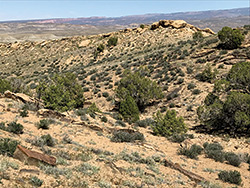 |
| The Naturita Formation exposed north of Arches National Park and south of I-70. |
This type of sedimentary sequence, e.g., one that reveals a change in depositional environment from fluvial to shallow marine indicates a transgression, or a rise in relative sea level that causes the sea to transgress, or flood what previously been land as the shoreline moves inland.
This particular tan sandstone indicates the transgression of the Western Interior Seaway, a vast inland sea that stretched across the heartland of North America from the Gulf of Mexico to the Arctic during the Cretaceous Period, a time of high sea level worldwide. As sea level rose, the shoreline moved across Utah from east to west leaving its telltale sedimentary sequence of river sand, swamp coal and shale, and beach sand and oyster fossils.
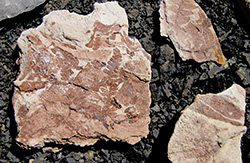 |
| Fern and other plant fossils from the Naturita Formation |
Until recently, the layer that recorded this transgression in Utah had long been known as the Dakota Sandstone. But detailed stratigraphy (the science of rock layers) research as well as a careful application of rock layer nomenclature conventions as defined in the North American Stratigraphic Code has revealed that these rocks are actually not part of the Dakota Formation and are more properly known as the Naturita Formation.
From the earliest days of the great geologic and geographic surveys of the West in the 1860s and 1870s, the sediments that recorded the transgressions of the Western Interior Seaway were known as the Dakota Sandstone everywhere they were found. The Dakota Sandstone was first described from outcrops along the Missouri River, on what would have been the east coast of the Western Interior Seaway. As these pioneering geologists continued to explore the west, they brought the name Dakota with them and applied it to rocks in Colorado and Utah that were deposited on the opposite (west) coast of this sea.
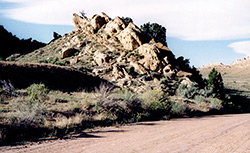 |
| Because the sandstone in the Naturita Formation is resistant to erosion, it can hold up low hogbacks where the rock layers are tilted. |
However, the packages of rocks on the east and west coasts of the Western Interior Seaway cannot belong to the same rock unit according to the definition of a formation, regardless of how similar they may appear or the fact that they were deposited in broadly similar environments. The rocks on the two coasts of the seaway must belong to different formations because they do not form a continuous unit as they are separated by the marine rock units of the seaway itself. Further, the eastern rivers flowed west to reach the sea, whereas in Utah, they flowed east to do so, and the two river systems eroded rocks in different source areas. Finally, the North America Stratigraphic Code has a strict prohibition on applying a single name to different bodies of rock.
The Naturita Formation was named after the small town in western Colorado where these rocks were described in the 1960s. Although the Naturita Formation was scientifically described nearly 60 years ago, it has only been in the last decade or so that geologists have been applying the term to the transgressive tan sandstone layer across most of Utah. (A separate transgressional sequence of sediments known as the Muddy Formation is present north of the Book Cliffs).
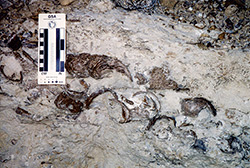 |
| Oyster fossils in the Naturita Formation in Capitol Reef National Park |
As for any change where people’s habits and language are engrained, it will take time for the new terminology to be widely adopted and understood. Most of the existing geologic maps, reports, and studies on the Cretaceous in Utah use
the term Dakota Sandstone. The field is also still in the transitional period where the new term is replacing the old. In fact, a scientific paper published in 2016 by Utah State Paleontologist Jim Kirkland and coauthors referred to these rocks as the “Naturita Formation (= Dakota Formation)” every single time they were mentioned.
The name change for these rocks is a good example of scientific progress and the processes of science. Similar changes include revisions to scientific names for organisms based on greater understanding of genetics and the relationships between species and the realization that not all dinosaurs are extinct since birds actually belong to the group of therapod dinosaurs.
While abandoning the name Dakota Sandstone in Utah probably will not provoke feelings as strong those associated with some scientific changes, such as the reclassification of Pluto to a dwarf planet, it is still a change. And changes take time—just hopefully not geologic time.
Special thanks to Jim Kirkland and Douglas Sprinkel.
|